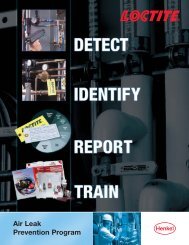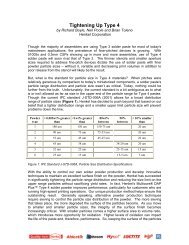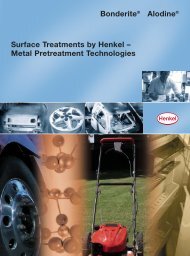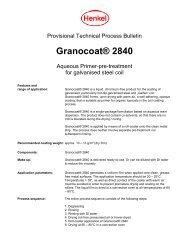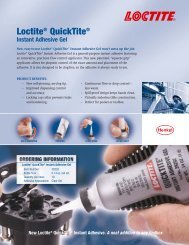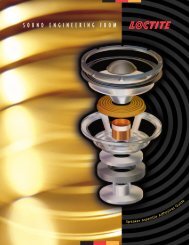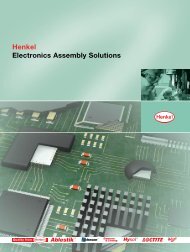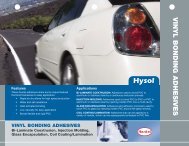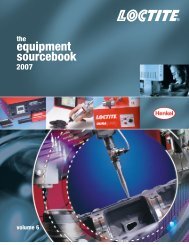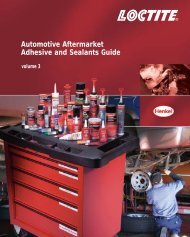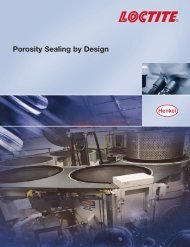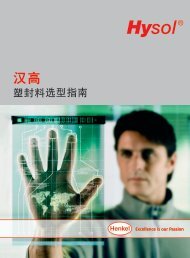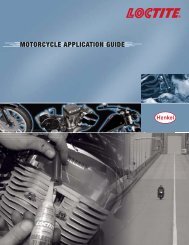Design Guide for Needle Bonding (LT-3720) - Henkel North America
Design Guide for Needle Bonding (LT-3720) - Henkel North America
Design Guide for Needle Bonding (LT-3720) - Henkel North America
- No tags were found...
You also want an ePaper? Increase the reach of your titles
YUMPU automatically turns print PDFs into web optimized ePapers that Google loves.
Introduction 1<strong>Needle</strong> Manufacturing Considerations 2<strong>Needle</strong> <strong>Design</strong> 2Process <strong>Design</strong> 4<strong>Henkel</strong> Corporation: A World of Resources 6Engineering Services 6Biocompatibility Screening 6Research & Development 6Training 6Adhesive Selection 7Overview 7Step 1: Select Adhesive Chemistries 8Light Cure Acrylics 9Light Cure Cyanoacrylates 10One-Part Heat-Cure Epoxies 11Step 2: Select Adhesive Candidates 12Viscosity 12Fluorescence 13Cure Speed 13Step 3: Review <strong>Needle</strong> Pull Strength Data to Finalize Candidates 14<strong>Needle</strong> Pull Strength 14Effect of Annular Rings 15Sterilization Resistance 15Thermal Stability 15Effect of Glass Transition Temperature (Tg) on Accelerated Aging 15Step 4: Screen Adhesive Candidates by Building Prototypes 16Step 5: Full Qualification of Lead Candidate(s) 16Test Methodology 17Determining the Experimental Test Matrix 17Determining the Accelerated Aging Conditions 18Determining the Test Method 19Experimental Procedure 20Process Equipment 22Ordering In<strong>for</strong>mation 23Appendix 1: Adhesive Selector ChartAppendix 2: <strong>Needle</strong> Pull Strength DataThe ProblemAdhesives are universally used <strong>for</strong> bondingcannulae to hubs in needle assemblies. It is criticalthat this joint is well sealed to prevent fluids, suchas blood or medicine, from leaking. It is alsoessential that the position of the cannula remainsfixed. Since the adhesive joint has a profound andvisible impact on the fitness-of-use of the needleassembly, needle designers often specify largesafety factors on the adhesive joint, while theirmanufacturers operate with six-sigma control limits.These stringent requirements cause the adhesiveselection and qualification process to be lengthyand expensive.The cannula to hub joint’s unique geometry furthercomplicates adhesive selection. The joint is smalland cylindrical, typically joining a stainless steelcannula to a plastic hub. Although many adhesivesuppliers publish comprehensive technical datasheets <strong>for</strong> their products, this data typically reflectsindustry standard tests such as lap shear strength.Since industry standard tests are not representativeof a real needle assembly, manufacturers cannotnormally extrapolate published data to actualper<strong>for</strong>mance in a needle design.Manufacturers with limited experience with aparticular needle design must often selectadhesives <strong>for</strong> qualification using limited in<strong>for</strong>mation.This can result in expensive test programs if a largenumber of adhesive candidates are evaluated. Onthe other hand, an inferior adhesive may beselected if a small number of adhesivecandidates are used.The SolutionThis guide is designed to provide a step-by-stepprocess <strong>for</strong> quickly and effectively selectingadhesives that are well suited <strong>for</strong> a specific needledesign. The process is supported by acomprehensive summary of adhesive selection andneedle per<strong>for</strong>mance data (See Appendix 1 and 2).The following topics are presented in this guide:1. <strong>Needle</strong> Manufacturing Considerations<strong>Design</strong> variables that affect needle pull strength,key considerations <strong>for</strong> the manufacturing process,and adhesive dispensing and curing equipment.2. Adhesive SelectionStep-by-step instructions on how to selectadhesives <strong>for</strong> a specific needle application,including detailed descriptions of each of the mostcommonly used adhesive types.3. Test MethodologyA comprehensive discussion on the experimentaltest matrix development and the needle pullstrength testing procedure.4. <strong>Henkel</strong>: A World of ResourcesA short description of the value added services weprovide needle designers and manufacturers.1
<strong>Needle</strong> <strong>Design</strong>The cut-away drawing below illustrates the keydesign variables that will affect the per<strong>for</strong>manceof a bonded needle joint. Each variable is discussedin detail and the Loctite ® needle test specimensare described.Hub MaterialHubs can be comprised of a variety of plasticsubstrates. Among those commonly used areABS, acrylic, polycarbonate (PC), polyethylene (PE),polypropylene (PP), polysulfone (PS), and polyurethane (PU).Loctite ® test specimens are ABS,Acrylic, PC, PE, PP, PS and PU.Core and Engagement LengthThe core is located beneath the well, where the innerdiameter of the hub decreases to a slight slip fit with thecannula. The length of the core is typically called theengagement length. As engagement length increases,needle pull strength increases until the strength of theadhesive joint exceeds that of the hub or cannula. Whenhigh viscosity adhesives are used, the adhesive often will notfill the entire engagement length.Loctite ® test specimens have a 0.16"engagement length.Well <strong>Design</strong>The well is used to promote flow of adhesive into the bondlineand to align the adhesive dispense tip with the cannula to hubjoint. As well diameter increases, the adhesive normally flowsmore rapidly into the well. The bond area also increases makingthe adhesive less likely to fail to the hub. As welldepth increases, the pull strength also increases.Loctite ® test specimens have a 0.060"diameter by 0.080" deep well.Cannula Gauge SizeCannula gauge size significantly affects both pullstrength and failure mode. As gauge size increases, thecircumference of the cannula decreases, reducing thesurface area of the joint and subsequently decreasingneedle pull strength. When bonding larger gauge sizessuch as 27 gauge, adhesives commonly fail to the cannulaand remain in the well. When bonding small gauge sizessuch as 22 gauge, the adhesive often fails to thehub and remains on the cannula.Loctite ® test specimens use 22 and 27 gauge cannulae.Annular RingsWith difficult-to-bond plastics, the adhesive may release fromthe hub at pull <strong>for</strong>ces below design requirements. To increasethe pull strength, annular rings can be designed into the hubby molding ringed recesses in the inner diameter of the coreand/or well. When the adhesive flows into the recessed ringsand cures, it bonds to the cannula and is mechanically held inthe rings. The typical depth <strong>for</strong> annular rings is 0.005 to 0.008".Loctite ® test specimens do not have annular rings.Diametrical Gap2The diametrical gap is the difference between the innerdiameter of the hub and the outer diameter of the cannula.A 0.002" diametrical gap is very common. As the diametricalgap decreases, the adhesive more slowly fills the annulararea in the core. As the diametrical gap increases, theadhesive is more likely to migrate out of the back of the huband pull strength may decrease. A diametrical gap of greaterthan 0.002" is uncommon unless the designer intends touse multiple gauge cannulae in one hub. In that scenario,diametrical gaps of 0.005 to 0.010" have been used.Loctite ® test specimens have a 0.002" diametricalgap <strong>for</strong> both 22 and 27 gauge assemblies.3
Process <strong>Design</strong>The process schematic below illustrates thekey steps in a needle bonding manufacturing process.Each process step and its impact on the per<strong>for</strong>mance ofthe needle assembly is discussed.Surface Treatment<strong>Needle</strong>s are commonly molded inpolyolefins such as polyethylene (PE)and polypropylene (PP) due to theirlow cost and versatile properties.Since PE and PP are difficult-to-bondplastics, it is common to treat thehub be<strong>for</strong>e assembly to increasethe pull strength.Corona treatment is popular inneedle assembly lines because itis an effective, in-line process. In acorona discharge process, the plasticis exposed to a corona discharge,usually in the presence of air andat atmospheric pressure. Thisroughens the surface and increasesthe surface energy of the plastic.Plasma treatment is a batchoperation by which the plastic isbombarded with ions of a gas atlow pressure. Since this is a batchprocess, it is commonly used inlaboratories. Experience indicatesthat the magnitude of the effect ofplasma and corona treatment isgenerally similar.Dispense Process Type<strong>Needle</strong> manufacturers may dispenseadhesive on the cannula be<strong>for</strong>e it isinserted in the hub or into the wellafter the cannula is inserted in the hub.For pre-assembly dispensing, a highviscosity adhesive must be used tohold the adhesive on the cannula.A typical viscosity range <strong>for</strong>pre-assembly dispensing is 3,000to 30,000 cP. The pre-assemblydispensing process has theadvantage of ensuring full adhesivecoverage with minimal flow times viathe needle insertion tip.Alternatively, manufacturers maydispense the adhesive after thecannula has been assembled withthe hub. This post-assemblydispensing process requires thata low viscosity adhesive be used,typically 20 to 3,000 cP. The lowerthe viscosity, the faster the adhesivewill achieve full coverage of the joint.100% Quality Inspectionusing Dispense Analyzer<strong>Henkel</strong> has developed state-of-the-artequipment <strong>for</strong> in-line 100% qualityinspection of the adhesive dispensingoperation. These systems can beused with viscosities ranging fromwater-thin liquids to thick pastes.They are industry proven in a widevariety of high speed dispensingapplications. These dispenseinspection systems use “real time”data acquisition to detect:• Plugged or broken dispense tips• Air bubbles• Missed dispensed cycles• Low pressure (undersized drops)• High pressure (oversized drops)The resulting output is a pressurewave<strong>for</strong>m which when compared toa pre-programmed standarddetermines whether the processis in or out of control. Data acquisitioncan be stored locally or to a LAN.Flow (Dwell) TimeWhen the adhesive is dispensed afterthe cannula and hub is assembled,some time will be required <strong>for</strong> theadhesive to flow into the welland core. In general, the lower theviscosity of the adhesive, the faster itwill achieve full coverage. For example,the time to fill the well may increasefrom 5 seconds at 100 cP to 40seconds at 9,000 cP.The required flow time to fill the core islonger since a much smaller gap existsas compared to the well. In fact, withhigher viscosity adhesives it iscommon <strong>for</strong> the adhesive not to fullyfill the core. A typical time to fill thecore is 20 seconds at 100 cP. Thiscan increase to 3 minutes at 6,000 cP.A flow time is not required if theadhesive is dispensed onto thecannula then inserted into the hub.In this process, the adhesive is<strong>for</strong>ced into the well and coreduring the needle insertion step.Cure MethodThe two most common cure methods<strong>for</strong> high volume production are:• Light curing• Heat curingLight curing processes essentiallyeliminate work in process. A typicalcure time is 6 to 20 seconds. Theprimary limitation is that light mustreach the bondline, although lightcure cyanoacrylates do have arapid secondary cure.Heat cure processes generally have a15 to 45 minute cure time. Thisincreases the time to manufactureand work in process when comparedto the light cure process. The curetemperature can also limit the typesof plastics that can be used<strong>for</strong> the needle hub..Fluorescence DetectionAlthough it is possible to per<strong>for</strong>min-line 100% audits on the dispensingprocess ensuring that the process is incontrol, that does not guarantee thatthe adhesive flowed into the jointcorrectly. All Loctite ® needle bondingadhesives are fluorescent to facilitatefinal inspection of the adhesive joint.Fluorescent detectors are often usedto per<strong>for</strong>m a present or not presentinspection. This can occur be<strong>for</strong>e orafter cure, depending on the lineconfiguration. If more precision isdesired, the fluorescence can bemonitored using a vision system,albeit at much higher expense.4 5
Light Cure CyanoacrylatesAdvantages• One-part• Solvent-free• Rapid fixture and cure with low intensitylight exposure• Rapid room temperature fixture• Cure in shadowed areas• Not inhibited by oxygen• Excellent adhesion to many substrates• Superior bond strength in shearand tensile modes• Primers available <strong>for</strong> polyolefins anddifficult-to-bond plastics• Wicking grade availableConsiderations• Poor peel strength• Limited gap cure in areas shielded from light(
Select AdhesiveCandidatesAppendix 1 presents the key per<strong>for</strong>manceattributes <strong>for</strong> 19 Loctite ® needle bonding adhesives.This in<strong>for</strong>mation should be used to select adhesivecandidates <strong>for</strong> further consideration.Several important selection variables are:ViscosityViscosity is the resistance of a fluid to flow. Fluidsthat flow easily, like water, have a low viscosity.Fluids that do not flow easily, such as windowcaulk, have high viscosities. Viscosity is typicallymeasured in centipoise (cP).The adhesive’s viscosity must be selected based onthe part design and manufacturing process used. Ifthe cannula will be assembled with the hub be<strong>for</strong>ethe adhesive is dispensed, a low viscosity (< 3,000cP) adhesive will ensure fast, consistent fill of thewell and core. If the adhesive will be dispensed onthe cannula be<strong>for</strong>e it is assembled with the hub orthere are large gaps between the cannula and thehub, a higher viscosity adhesive (3,000 to 30,000cP) will ensure that the product does not migrateprior to assembly and/or ensure optimum gap fill.Table 2 presents the time required to fill the hubwell and core as a function of adhesive viscosity.These flow times were determined using a highspeedcamera when dispensing Loctite ® light cureacrylic adhesives on standard specimens that had a0.002" diametrical gap.TABLE 2: Viscosity-Flow Time Relationshipwith 0.002" Diametrical Gap (minute:second)VISCOSITY(cP)MAX. TIMETO FILL WELLMAX. TIMETO FILL COREOther factors such as the thixotropic ratio andsurface tension of a particular adhesive candramatically effect flow time. There<strong>for</strong>e, the data inTable 2 should only be used as a general guideline.On-part testing should determine actual flow timesrequired <strong>for</strong> a specific manufacturing process.Depending on the needle joint design,manufacturers may want to quickly fill the annularspace in the core. If the cannula protrudes from thecore as shown in Figure 1A, the surface tension ofthe adhesive will typically prevent the adhesive fromflowing out of the core. Most needle assemblies aredesigned with a 0.002" diametrical gap. With thisgap, even very low viscosity adhesives (20 cP) willnot migrate after prolonged delays be<strong>for</strong>e cure. Byfilling the annular space in the core quickly, needlepull strength will be maximized.If the cannula ends in the core as shown in Figures1B and 1C, it is more likely that the adhesive willflow beyond the end of the cannula. Capillary actioncan then pull the adhesive into the inner diameter ofthe cannula, obstructing the needle and limiting fluidflow. As the flow time increases, adhesive is morelikely to migrate. Table 3 illustrates the potential <strong>for</strong>cannula clogs as a function of adhesive viscosityand the flow time between dispense and cure.This testing was conducted using a seatedcannula with a 0.002" diametrical gap anda light cure acrylic adhesive.TABLE 3: Clog-Flow Time RelationshipFLOWAdhesive Viscosity (cP)TIME 100 500 1,0007 sec – – –14 sec Clogs – –5 min Clogs Clogs –As an adhesive is heated, its viscosity drops rapidly.For example, an epoxy that has a viscosity of20,000 cP at room temperature may have aviscosity of 3,000 cP at 65 o C (150 o F). Conversely, ifan adhesive is cooled, its viscosity will rise.This viscosity-temperature relationship createsan interesting advantage <strong>for</strong> one-part heat cureepoxies. Their viscosity will initially drop as theadhesive is heated and will then begin to risesharply as the adhesive cures, allowing heat cureepoxies to achieve full coverage that would not bepossible with light cure acrylic adhesives of thesame viscosity dispensed at room temperature.FluorescenceFluorescent dyes absorb UV light.The energy they absorb excites thedye molecule, emitting a fluorescentlight that is typically blue in color. Thislight can be visually observed with ablack light if held over the adhesive ina darkened environment. Detectors,such as the Loctite ® FluorescenceDetector, part number 98083, canbe used alone or in conjunctionwith vision systems to per<strong>for</strong>min-line confirmation that theadhesive is present in the bondline.When fluorescent dye is added tolight curing adhesives, the dyedecreases the light cure responseand can also decrease needle pullstrengths. By quantitativelydetermining the minimumlevel of fluorescencenecessary <strong>for</strong> robustin-line detection, Loctite ®needle bondingadhesives are <strong>for</strong>mulatedwith the optimumbalance of fluorescence,light cure response, andpull strength.Cure SpeedCure speed defines howlong the adhesive mustbe exposed to a givencondition be<strong>for</strong>e it is fullyconverted from a liquid to a solid. Cure speed willdictate work-in-process levels. Typically, the rapidcure of light cure acrylics and light curecyanoacrylates results in minimal work-in-process,whereas the 15 to 45 minute cure times of onepartheat-cure epoxies necessitates more inprocesstime.100 0:05 0:20500 0:07 0:30121,000 0:15 1:206,000 0:30 3:109,000 0:40 4:00A. Protruding CannulaFigure 1: Common <strong>Needle</strong> <strong>Design</strong>sB. Recessed Cannula C. Seated Cannula13
Review <strong>Needle</strong> PullStrength Data toFinalize CandidatesOnce initial adhesive candidates have beenselected, the next step is to review the per<strong>for</strong>mancedata of each adhesive to narrow down the field ofcandidates. <strong>Henkel</strong> has generated needle pullstrength, sterilization resistance, and acceleratedaging data to be used by needle manufacturersas a baseline estimate <strong>for</strong> adhesive per<strong>for</strong>mancein a specific needle design.<strong>Needle</strong> Pull StrengthAppendix 2 presents the needle pull strengthsachieved by the 19 Loctite ® needle bondingadhesives. Pull strengths were evaluated on sevendifferent hub plastic types and two different cannulagauge sizes. For more in<strong>for</strong>mation on the testspecimens used, please refer to the TestMethodology section of this guide.The plastic types evaluated were:• ABS• Acrylic• Polycarbonate (PC)• Polyethylene (PE)• Polypropylene (PP)• Polystyrene (PS)• Polyurethane (PU)The cannula gauge sizes evaluated were 22 and 27gauge. Two different gauge cannulae wereselected to represent the upper and lowerends of the commonly used range.Effect of Annular RingsRings are often molded into theinner diameter of the core and/orwell to increase needle pullstrength, particularly when the hubmaterial is a difficult-to-bond plastic.The adhesive fills the rings and mustbe physically deflected <strong>for</strong> the needleto be moved axially.In a joint with rings, the adhesionto the hub and the resultingmechanical interlocking will providea significant contribution to needlepull strength. The lower the adhesionto the hub, the higher the relativecontribution of the mechanicalinterlocking to the needle pull strength.In general, the more rigid the adhesive is,the more difficult it is to deflect theadhesive and the higher the magnitudeof the contribution frommechanical interlocking.The test specimens used <strong>for</strong> this guide do nothave annular rings. Thus, the needle pullstrengths presented in this guide areconservative estimates.Sterilization ResistanceAll needle assemblies must besterilized be<strong>for</strong>e use. Appendix 2presents the effect that gamma, EtO, andautoclave sterilization have on needle pull strength.Since autoclaving is often used <strong>for</strong> reusabledevices, this sterilization method was evaluated<strong>for</strong> both 1 and 5 autoclave cycles.The sterilization resistance testing wasper<strong>for</strong>med on two different size cannulae andthree different plastics since both factors canaffect the ability of an assembly to maintain pullstrength after sterilization.Thermal StabilityAppendix 2 illustrates the thermalstability of Loctite ® needle bonding adhesives.<strong>Needle</strong> manufacturers commonly per<strong>for</strong>maccelerated aging tests to predict the stability of pullstrength over the life of the assembly.This testing was per<strong>for</strong>med on two different sizecannulae and three different plastics since both ofthese factors can affect the relative thermal stabilityof an assembly with a given adhesive.Effect of Tg on Accelerated AgingMost needle manufacturers per<strong>for</strong>m acceleratedaging tests on their needles to predict theper<strong>for</strong>mance of the needle over the life of theassembly. Often the Arrhenius or Weibullequations are used to predict the life of theassembly by heating the bonded assemblyand correlating a time at an elevatedtemperature to an equivalent life at ambientconditions. These techniques are based on theassumption that the failure mechanism does notchange as the conditioning temperature increases.When the temperature of the adhesive is above theglass transition temperature (Tg), the adhesivesoftens and the free volume in the polymeric matrixincreases dramatically, accelerating the degradationof the adhesive and violating that fundamentalassumption. If accelerated aging studies areconducted above the Tg of the adhesive and theneedle assembly will not actually be exposed tothese temperatures in service, the results may leadto erroneous conclusions on the reliability of thebonded assembly.The Tg does not determine the recommendedservice temperature range <strong>for</strong> an adhesive. Forexample, many epoxies have a Tg of 50-55°Cand have excellent heat aging up to 175°C.1415
Screen AdhesiveCandidates byBuilding PrototypesOnce final adhesive candidates have been selected,the needle designer should screen the candidateson actual assemblies to confirm that the adhesivemeets or exceeds all per<strong>for</strong>mance requirements.Since screening experiments are often conductedon a larger group of adhesive candidates, thereplicates per experimental run are often relativelylow; 5 to 15 observations per experimental run ismost common. This step will ensure that themanufacturer is getting results consistent withexpectations and is often used to selecta smaller group of lead candidates <strong>for</strong>final qualification testing.<strong>Henkel</strong> encourages our needle bondingcustomers to partner with us whendeveloping adhesive manufacturing processes.Our global engineering support staff will workclosely with you to select and qualify adhesives.We often partner with our customers by:• Recommending adhesive candidatesFull Qualificationof Lead CandidatesOnce the adhesives have been screened,manufacturers can be confident that the leadcandidates will be qualified successfully.The lead candidates will then go throughthe full qualification test program.Determiningthe ExperimentalTest MatrixThe Selection of AdhesivesThe adhesive families best suited <strong>for</strong> high speedneedle manufacturing operations were identified tobe light cure acrylics, light cure cyanoacrylates, andone-part heat-cure epoxies. For each of theseadhesive families, <strong>Henkel</strong> has developed a line ofadhesives specifically <strong>for</strong> needle bonding with highpull strengths, fast cure speed, and goodfluorescence <strong>for</strong> automated in-line detection.Fourteen light cure acrylics, two light curecyanoacrylates, and three one-part heat-cureepoxies are included in this guide.The Selection of Plastics<strong>Henkel</strong> identified the various types of plasticsthat are commonly used <strong>for</strong> needle assembliesby surveying needle manufacturers, plasticsuppliers, and plastic molders. Table 4 presentsthe seven identified plastic types and thespecific grades used.TABLE 4: Plastic Grades UsedThe Selection of Gauge SizesGauge size has astatisticallysignificant effecton the pullstrengths achievedby an adhesive.Pull strengthdecreases ascannula diameterdecreasesbecause thesmallercircumference ofthe cannularesults in asmaller bond area.When the gauge size changes, the failure mode canalso change. For large gauge sizes, the adhesiveoften fails to the cannula and remains in the hub.For small gauge sizes, the adhesive often fails tothe hub and remains on the cannula.To investigate the effect of gauge size, two gaugesizes, 22 and 27, were selected to represent theupper and lower limits of the range of commonlyused needles.• Assisting in the qualification process byconducting testing in our facilities• Reviewing the manufacturing line• Offerering troubleshooting assistanceTo contact us, please call1-800-LOCTITE (562-8483).ABSACRYLICPCPEPPPSPUTerlux 2802 TR, NaturalCyrolite G20-HIFLO, NaturalGE HP2-112, NaturalPhillips HD 9018 HDPE, NaturaProfax SD242, NaturalBASF 145DPellethane 2363-75D, NaturalSince polyethylene and polypropylene aredifficult-to-bond plastics that often require surfacetreatment to achieve high pull strengths, theeffect of plasma treatment was also evaluatedon these substrates.1617
Determiningthe AcceleratedAging ConditionsWhen qualifying an adhesive <strong>for</strong> a needle bondingapplication, most manufacturers have acomprehensive qualification program that evaluatesthe effect of sterilizing the needle assembly andattempts to evaluate the strength retention of theneedle assembly over the life of the needle.Sterilization ResistanceLight cure acrylics, light cure cyanoacrylates, andone-part heat-cure epoxies have excellentresistance to gamma and EtO sterilization.Autoclaving is an aggressive sterilizationprocedure that may adversely affect theper<strong>for</strong>mance of needle assemblies.The sterilization resistance <strong>for</strong> a needle assembly isdependent on many factors that make it difficult tomake generalizations concerning compatibility.Variables that can affect sterilization resistanceinclude, but are not limited to, the adhesive used,the hub substrate, the hub design, the cannulagauge size, and the sterilization profile.To definitively determine the sterilization resistanceof Loctite ® needle bonding adhesives, industrystandard sterilization cycles were selected (seeTable 5) and evaluated on polycarbonate,polystyrene, and plasma treated polypropylenehubs with both 22 and 27 gauge needles.To characterize the thermal stability of Loctite ®adhesives, strength retention conditioningat 60°C <strong>for</strong> 4 and 8 weeks was determined onpolycarbonate, polystyrene, and plasma treatedpolypropylene hubs with both 22 and 27gauge needles.Determiningthe Test MethodWhen evaluating the strengthachieved by an adhesive,industry standard testspecimens such as lapshear and block shearspecimens are typicallyused. Althoughpublished testingconducted with standardspecimens does give a goodindication of the adhesion to a givensubstrate, these results cannot beextrapolated to per<strong>for</strong>mance in a specific needledesign. This often makes it impossible <strong>for</strong> needlemanufacturers to select the optimum adhesive<strong>for</strong> their application without conductingexhaustive and expensive testing.<strong>Henkel</strong> could have used cannulae and hubs frommedical manufacturers to per<strong>for</strong>m needle pullstrength testing on their production assemblies.However, this is not practical when creating data <strong>for</strong>a selector guide. The proprietary nature of needledesigns and the plastic <strong>for</strong>mulations used <strong>for</strong>needles would make it impossible to share the datawith the needle manufacturing community. Lack ofcontrol of the test specimens would also make itdifficult to generate historical per<strong>for</strong>mance data.To overcome these limitations, <strong>Henkel</strong> has designeda test specimen that simulates a standard needlebonding joint. Figure 2 details the hub design. Theonly dimension that changes from 22 to 27 gaugespecimens is the inner diameter of the core on the hub.The inner diameter of the core is designed to havea 0.002" diametrical gap with the cannula <strong>for</strong> bothgauge sizes. Unsharpened cannulae were providedby a major needle manufacturer <strong>for</strong> this testing.There are no annular rings in the well or the coreof the test specimen. Often annular rings areadded to increase pull strength by adding mechanicalinterlocking. Since annular rings were not moldedinto the standard test specimens, the pull strengthspresented in this guide are a conservative estimateof the pull strength that will be achieved if annularrings are used..313.313.175 DIA..060 DIA..125TABLE 5: Sterilization Cycles.080GAMMA 25 to 30 KGYEtO STERIS TM cycle 9242AUTOCLAVE121°C, 15 psi steam <strong>for</strong>6 minutes per cycleThermal Stability.250.161.233.042.525Manufacturers commonly use accelerated aging todecrease time to market with new designs.Accelerated aging is typically comprised of heatingthe needle assemblies to an elevated temperature,conditioning them at that temperature <strong>for</strong> a givenperiod, allowing the conditioned assembly toacclimate back to ambient conditions, anddetermining the pull strength using destructivetesting. Many factors affect thermal stabilityincluding, but not limited to, the adhesive used, thehub substrate, the hub design, the cannula gaugesize, and the conditioning temperature.18GaugeSize.170DIM "A"DIMENSION “A”Hub InnerDiameterCannulaOuterDiameterDiametricalGap22 0.030" 0.028" 0.002"27 0.018" 0.016" 0.002"Note: Loctite ® <strong>Needle</strong> Specimen did not incorporate annular ringsFigure 2: Loctite ® <strong>Needle</strong> Specimen19
Experimental ProcedureSurface Preparation1. All cannulae were cleaned with isopropyl alcohol.2. If indicated, the hubs were plasma treated inoxygen on level 10 <strong>for</strong> 10 minutes.Adhesive Applicationand Cure Method1. The adhesive was manually dispensed using aLoctite ® Analog Syring Dispensing System (Part #98021) semi-automated dispenser.1.1. For adhesives with a viscosity of less than3,000 cP, the adhesive was applied afterassembling the cannula and hub.1.1.1. The cannula was manuallyinserted into the hub.1.1.2. A small drop of adhesive was applied atthe cannula to hub interface. The adhesivequantity was set to ensure that the adhesivecompletely filled the well creating a domedadhesive fillet.1.2. For adhesives with a viscosity of greater thanor equal to 3,000 cP, the adhesive was appliedbe<strong>for</strong>e assembling the cannula and hub.1.2.1. A small drop of adhesive was applied tothe cannula approximately 1.6 mm (0.063 in)from the end to be mated to the hub. Theadhesive quantity was set to ensure that theadhesive completely filled the well creating adomed adhesive fillet.1.2.2. The cannula was manually insertedinto the hub.2. The adhesive was allowed to flow <strong>for</strong> thetime indicated in Table 6.3. The adhesive was cured.3.1. For light cure adhesives, the needlespecimens were cured in a high intensityelectrodeless light cure chamber with anirradiance of 850 to 1000 mW/cm 2 at365 nm <strong>for</strong> 10 seconds.3.2. For heat cure epoxies, the needlespecimens were cured <strong>for</strong> 30 minutesat 100°C.Conditioning1. If indicated, the needle assemblies were sterilizedusing the cycles described in Table 5.2. If indicated, the needle assemblies were heataged in a <strong>for</strong>ced air convection oven.Test Method1. Assemblies were tested in the Loctite ®needle pull fixture on an Instron 4204 mechanicalproperties tester equipped with a 1 kN load cell at apull speed of 4 "/min.2. Ten replicates of each assembly were tested.TABLE 6: Flow Time vs. ViscosityVISCOSITY (cP)Flow Time(minute:second)100-499 0:30500-999 0:401,000-8,999 1:30>9,000 4:1020 21
<strong>Needle</strong> PullStrength DataLOCTITE ®BRANDPRODUCTStrength, IbHub MaterialNUMBER ABS ACRYLIC PC PE PE * PP PP* PS PU3911 TM 37 35 36 7 24 14 19 43 23ABS ACRYLIC PC PE3911 TM 28 33 26 9 24 11 23 31 193912 TM 19 17 14 1 16 2 16 15 173913 TM 27 24 25 9 24 5 16 29 223921 TM 27 27 24 9 22 7 28 20 233922 TM 19 19 14 4 17 5 21 15 183924 TM 16 18 11 3 22 5 22 11 133926 TM 12 13 10 4 16 8 17 6 113933 TM 19 18 18 4 16 15 17 19 173936 TM 17 16 16 8 17 10 16 16 143941 TM 27 29 24 12 29 7 22 26 153942 TM 35 37 37 19 30 14 33 36 323943 TM 34 33 33 12 26 10 26 32 273971 TM 21 29 18 3 25 2 5 27 253972 TM 22 23 16 1 23 2 4 19 263981 TM 33 32 17 3 31 3 22 28 343982 TM 35 33 19 8 23 3 30 30 333984 TM 32 33 26 12 31 8 26 30 314306 TM 7 3 20 4 10 2 5 2 114307 TM 2 2 2 1 5 1 3 2 61-10 11-20 21-30 31-40 41-50 51+* Plasma Treated 3912 TM 35 34 35 2 30 1 12 33 303913 TM 40 40 42 12 31 7 22 48 233921 TM 61 56 50 10 35 12 45 45 343922 TM 55 54 46 11 40 17 49 40 353924 TM 32 32 27 3 22 5 27 21 283926 TM 18 19 24 4 19 4 20 15 193933 TM 33 30 41 5 24 8 23 34 303936 TM 22 23 33 7 17 18 18 31 253941 TM 53 50 39 8 30 6 40 47 223942 TM 62 57 61 6 52 21 46 59 423943 TM 55 50 59 3 39 8 26 43 433971 TM 41 44 40 3 28 5 7 46 413972 TM 40 41 40 1 38 3 6 33 383981 TM 68 62 20 3 48 4 36 43 633982 TM 66 67 28 4 49 5 46 56 633984 TM 51 57 24 3 45 6 33 50 444306 TM 31 43 55 9 22 4 12 22 224307 TM 40 34 26 1 22 1 4 20 3322 GAUGE NEEDLE27 GAUGE NEEDLENEEDLE PULL STRENGTHSLOCTITE ®BRANDPRODUCTNUMBER22 GAUGE NEEDLE27 GAUGE NEEDLE3911 TM3912 TM3913 TM3921 TM3922 TM3924 TM3926 TM3933 TM3936 TM3941 TM3942 TM3943 TM3971 TM3972 TM3981 TM3982 TM3984 TM4306 TM4307 TM3911 TM3912 TM3913 TM3921 TM3922 TM3924 TM3926 TM3933 TM3936 TM3941 TM3942 TM3943 TM3971 TM3972 TM3981 TM3982 TM3984 TM4306 TM4307 TM*Plasma TreatedSTERILIZATION RESISTANCE% Strength Retention After SterilizationAutoclaveGammaEtO1 cycle 5 cyclesPC PP* PS PC PP* PS PC PP* PC PP*115 145 110 100 145 100 85 125 60 60150 100 120 80 70 90 95 70 70 70105 90 105 90 95 90 55 65 50 55120 95 105 120 105 105 105 100 95 9590 80 105 110 85 115 80 125 80 120155 130 130 150 125 130 110 115 130 110115 115 110 90 105 120 85 90 80 75105 80 105 95 110 95 100 90 95 8565 95 55 105 110 95 100 85 65 75125 95 115 135 105 110 90 90 55 8085 110 90 90 90 85 90 90 80 5595 155 115 80 130 100 75 120 65 9095 90 100 85 160 85 30 70 5 60105 100 115 100 115 135 10 65 10 65110 145 100 110 140 100 90 75 90 8575 110 85 95 100 85 90 65 35 40105 90 90 100 100 75 110 65 30 3555 75 65 75 90 55 45 40 25 50120 75 75 90 75 135 25 75 20 7595 105 105 90 95 85 70 80 45 6090 65 100 65 65 100 90 35 90 35115 100 105 85 95 95 60 65 60 65125 110 130 115 115 150 80 105 105 90195 145 175 115 150 165 130 145 120 140150 110 130 135 110 120 105 95 115 8095 125 100 105 110 165 85 85 105 70120 110 120 115 110 115 120 110 105 100150 135 185 115 120 120 90 115 40 10090 100 100 95 105 150 130 120 85 100105 80 90 95 80 85 75 90 55 5590 100 100 105 105 105 85 95 65 9590 100 110 55 80 65 55 120 5 8090 100 105 55 125 65 25 75 10 75100 140 95 100 110 90 60 65 75 100105 90 100 95 75 100 125 70 50 4090 80 75 80 70 80 100 110 75 6530 80 50 40 100 150 15 40 25 8050 50 50 200 100 100 100 65 100 65
USALocal Loctite Brand Adhesives andSealants Specialist1.800.323.5106Nearest Authorized Loctite Brand DistributorArrange an in-plant seminarTechnical Product Assistance1.800.LOCTITE (1.800.562.8483)To place an order1.800.243.4874<strong>Henkel</strong> Corporation1001 Trout Brook CrossingRocky Hill, Connecticut 06067860.571.5100Fax: 860.571.5465CanadaLocal Loctite Brand Adhesives andSealants SpecialistNearest Authorized Loctite Brand DistributorArrange an in-plant seminarTechnical Product AssistanceTo place an order1.800.263.5043 (within Canada)<strong>Henkel</strong> Canada Corporation2225 Meadowpine Blvd.Mississauga, Ontario L5N 7P2800.263.5043 (within Canada)905.814.6511Fax: 905.814.5391MexicoLocal Loctite Brand Adhesives andSealants SpecialistNearest Authorized Loctite Brand DistributorArrange an in-plant seminarTechnical Product Assistance01.800.901.8100 (within Mexico)To place an order01.800.849.9412 (within Mexico)<strong>Henkel</strong> Capital, S.A. de C.V.Calzada de la Viga s/n Fracc. Los LaurelesLoc. Tulpetlac, C.P. 55090Ecatepec de Morelos, Edo. de MéxicoTel: 011.52.55.5836.1300Tel: 01.800.90.181.00 (within Mexico)Fax: 011.52.55.5787.9004Latin <strong>America</strong>BrazilLocal Loctite Brand Adhesives andSealants SpecialistNearest Authorized Loctite Brand DistributorArrange an in-plant seminarTechnical Product AssistanceTo place an order55.11.4143.70000800.122334 (within Brazil)<strong>Henkel</strong> Ltda.Rua Karl Huller, 136 - Jd.Canhema 09941-410Diadema/SP, BrazilTel: 55.11.4075.8955Fax: 55.11.4075.8887<strong>Henkel</strong> Argentina S.A.Tte. Cnel. Magán 1990 – Sarandi(B1872HRN) Avellanda, Buenos Aires,ArgentinaTel: 54.11.4001.0100Fax: 54.11.4205.3442<strong>Henkel</strong> Chile S.A.Av. Apoquindo 3355,Oficina 8 - 1º PisoLas Condes, Santiago, ChileTel: 56.2.2333606Fax: 56.2.2341448<strong>Henkel</strong> Colombia S.A.Calle 17 No. 68-B-73,Bogotá D.C., ColombiaTel: 571.423.9000Fax: 571.425.1331<strong>Henkel</strong> Venezuela S.A.Zona Industrial PruincaCalle 2 Parcela 31 y 32Guacara - Edo Carabobo, VenezuelaTel: 5824.5560.2611Fax: 5824.5560.2660DisclaimerThe in<strong>for</strong>mation contained herein is intended to beused solely as a general indicator of per<strong>for</strong>mance <strong>for</strong>needle bonding applications. The in<strong>for</strong>mation isbelieved to be accurate, and is well suited <strong>for</strong>comparative analysis, however, the testing wasper<strong>for</strong>med using a limited number of adhesivelots, plastic lots, and replicates. Consequently,this makes the in<strong>for</strong>mation contained hereininappropriate <strong>for</strong> specification purposes.<strong>Henkel</strong> Corporation can not assume responsibility<strong>for</strong> the results obtained by others over whosemethods we have no control. It is the user’sresponsibility to determine suitability <strong>for</strong> the user’spurpose of any production method mentioned hereinand to adopt such precautions as may be advisable<strong>for</strong> the protection of property and of personsagainst hazards that may be involved in thehandling and use thereof.In light of the <strong>for</strong>egoing, <strong>Henkel</strong> Corporationspecifically disclaims all warranties of merchantabilityor fitness <strong>for</strong> a particular purpose arising from saleor use of Loctite ® products. <strong>Henkel</strong> specificallydisclaims any liability <strong>for</strong> consequential or incidentaldamages of any kind, including lost profits. Thediscussion herein of various design criteria is not tobe interpreted as representation that they are freefrom domination of patents owned by others or asa license under any <strong>Henkel</strong> patents which maycover such processes or compositions. Werecommend that each prospective user test theproposed application in its manufacturing processusing this data as a guide. The products andprocesses in this guide may be covered by oneor more United States or <strong>for</strong>eign patentsor patent applications.Except as otherwise noted, all trademarks in this catalog aretrademarks of <strong>Henkel</strong> Corporation in the U.S. and elsewhere.® denotes a trademark registered in the U.S. Patent andTrademark Office.Krytox is a registered trademark of E.I. DuPont de Nemours Co., Inc.NSF is a trademark of NSF International.CSA is a trademark of CSA International.Steris is a trademark of Steris Corporation.UL is a trademark of Underwriter’s Laboratories, Inc.© Copyright 2004. <strong>Henkel</strong> Corporation. All rights reserved.Printed in U.S.A. 2238 <strong>LT</strong>-<strong>3720</strong> 6/04



